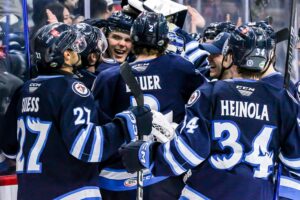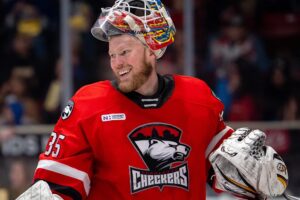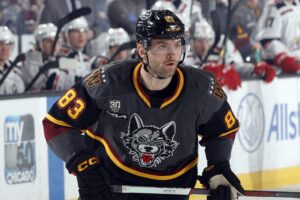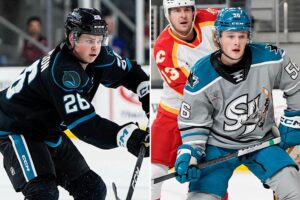by Brian Smith || AHL On The Beat Archive
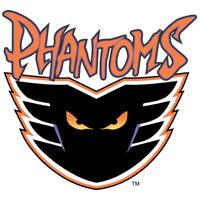 When the Philadelphia Phantoms were founded in 1996, nobody really knew how things might go for the team. Most of the questions centered around whether it would be successful as far as ticket sales and attendance were concerned. At the time, the Flyers and Sixers were moving to the brand-new building then known as the CoreStates Center, and a tenant was needed for the soon-to-be-vacant, but still-viable Spectrum.
When the Philadelphia Phantoms were founded in 1996, nobody really knew how things might go for the team. Most of the questions centered around whether it would be successful as far as ticket sales and attendance were concerned. At the time, the Flyers and Sixers were moving to the brand-new building then known as the CoreStates Center, and a tenant was needed for the soon-to-be-vacant, but still-viable Spectrum.
So the Flyers went out and acquired an expansion franchise in the American Hockey League and placed it in the building.
The result was better than even the most optimistic person could imagine. The Phantoms were successful immediately both on and off the ice. What’s more, the presence and success of the team has had a direct impact on the Philadelphia Flyers over the years. As a result, the two teams have become more intertwined than any other affiliation in professional hockey.
The connection between the two teams goes back almost to the very beginning. The Phantoms were officially born on December 18, 1995, when the American Hockey League granted an expansion franchise to the Flyers organization. In March of 1996, the Flyers tabbed one of their own, Bill Barber, to lead the team as its head coach. Another former Flyer, Mike Stothers, who had been coaching the team’s prospects as an assistant in Hershey, came to the Phantoms along with the rest of the Flyers farmhands who had been playing for the Bears.
Barber and Stothers wanted to find some solid veteran leadership for their new team. They centered their search on a defenseman named John Stevens, who Stothers knew from the days the two had played together for the Flyers and for Hershey in the mid- to late-1980s. Stevens had been captaining the Hartford Whalers’ AHL team in Springfield, Massachusetts for the past three years. Stothers called Stevens, there was some conversation, and Stevens agreed to come lead the new club as its first captain.
It seemed like a simple-enough signing, an organization going out and finding someone to help mentor its young players and prepare them for the NHL. Nobody could have known that the teaching process would still be going on 12 years later.
Later that fall, the Phantoms took the ice with unprecedented vigor. This was a team that was made up mostly of players that had been the nucleus of a Hershey Bears squad that had finished the previous season with a somewhat pedestrian 36-30-11-3 record and a first-round playoff exit. In Philadelphia, with a new coach and a few new pieces, it was different. The Phantoms won the AHL’s regular-season title in each of their first two seasons. The first year resulted in a record of 49-18-10-3 for 111 points, still to this day the best record in team history.
Never in the 61 years of the American Hockey League’s existence had a team had such a fruitful inaugural season. Peter White led the league in scoring with 105 points on 44 goals and 61 assists. The team sent five players to the All-Star Game, and placed an additional four on the league’s end-of-season All-Star squads. But the season ended with a second-round playoff loss to Hershey, the eventual Calder Cup champions of that year, and left the team feeling like it had to take care of some unfinished business.
Next year, they did just that. The Phantoms matched everything they’d done the previous regular season – another regular season points championship, another division championship, and came up just five points short of the previous year’s total. But this time, they marched through the playoffs. Rochester went down in four games in the best-of-five first round, followed by a four-game sweep of Hershey and a six-game defeat of Albany.
The Calder Cup Finals matched the Phantoms against the Saint John Flames. The series started in epic fashion at the Spectrum on May 30, when Game 1 went to double overtime before Sean O’Brien won it for the Phantoms with a goal 1:27 into the second extra session. The Flames answered with an overtime win of their own in Game 2, but the Phantoms returned serve with an overtime win in Game 3 on the road. Jim Montgomery recorded a hat trick in a 6-4 win in Game 4 that put the Phantoms on the brink of a championship, but Saint John didn’t go quietly and won 6-1 in Game 5 to send the series back to Philadelphia.
A capacity crowd of 17,380 packed the Spectrum for Game 6, and it was over almost before it started. Montgomery scored 32 seconds into the game, the Phantoms had a 2-0 lead at the first intermission, and they never looked back en route to a 6-1 victory. The building was so loud at times that the players couldn’t even hear themselves on the bench. It was just the second hockey championship won in the Spectrum, joining the Flyers first Stanley Cup championship in 1974.
The Phantoms were a rousing success right out of the gate in the attendance records as well. The team led the American Hockey League in attendance in each of its first six seasons, peaking at an average of 12,002 fans per game in the 1998-99 season. The Phantoms have played before 20 Spectrum sellouts in their history, including seven consecutive in January and February of 1998.
As the years went by, the Phantoms continued to make history and memories. The 1999 AHL All-Star Classic came to the First Union Center in February of that year, bringing with it some of the best young NHL prospects in North America. Five players, plus Barber and Stothers, represented the Phantoms in the contest, with goaltender Jean-Marc Pelletier earning the game’s MVP honors.
It wasn’t long before that All-Star game that an unfortunate in-game incident took place that would end up altering the course of the team’s history. On December 13, 1998, the Phantoms were on the road in Lexington taking on the Kentucky Thoroughblades when an errant puck hit Stevens in the right eye.
The injury ended up being so serious that it ended his career. A little less than two months later, on February 9, Stevens made his retirement official. His hockey life jumped onto an entirely new path when he became an assistant to Barber.
After a little more than a full season in that role, Stevens took the helm as head coach in the summer of 2000 when Barber became an assistant with the Flyers. He spent six seasons running the Philadelphia bench, building a record of 230-181-33-25-11.
The fourth season of that run was 2004-05, the year of the NHL lockout. It had an inauspicious beginning when the club dropped its first two games. But the Phantoms then reeled off a 17-game winning streak, the longest in AHL history, which lasted from October 22 to November 27.
Although the Phantoms missed out on the division title by three points to Binghamton, the Senators didn’t make it out of the first round, suffering an upset at the hands of Wilkes-Barre/Scranton. The Phantoms, meanwhile, took care of Norfolk in a six-game series and then knocked out the Penguins in five games in the East Division Finals. Wilkes-Barre/Scranton led 4-1 near the midway point of the third period when the Phantoms reeled off six unanswered goals to take a 7-4 win and roar on to meet Providence in the conference finals.
For the third straight series, the Phantoms won the first two games and eventually took a 3-1 lead over the P-Bruins. After finishing Providence off in six games, it was back to the Calder Cup Finals, this time against the Chicago Wolves.
In a Finals series that was much closer than the record books indicate, the Phantoms squeaked out wins in each of the first three games – 1-0 in Game 1, 2-1 in double overtime in Game 2, and 2-1 in Game 3. On June 10, 2005, an AHL-record 20,103 fans packed the Wachovia Center to watch the Phantoms win their second Calder Cup with a 5-2 victory, setting off a party like none the AHL had ever seen.
In the summer of 2006, Stevens moved up to the big club, joining the Flyers as an assistant. It wasn’t long before he was the head coach, and another new chapter began in a journey that started all those years ago when a veteran defenseman signed on to lead a brand-new team. There’s a lot of the story that has yet to be written, as evidenced by the Flyers run to the Eastern Conference Finals last year, which laid the foundation for even greater things ahead.
At the same time, the Phantoms have moved forward under the tutelage of Kjell Samuelsson, Craig Berube, and now John Paddock, who takes the team into a 2008-09 season that will be its last in the historic Spectrum. Along the way, more than four million fans got to know great people like Frank Bialowas and Neil Little, Brian Boucher and John Slaney, Ben Stafford and Riley Cote, and countless others.
Nearly 100 players have gone from the Phantoms to the Flyers, including the likes of Mike Richards, Jeff Carter, Randy Jones, Cote, Steve Downie, Ryan Parent and Antero Niitymaki, all of whom are key components of a Flyers roster on the cusp of greatness. And there are players who will be among the last to grace the Spectrum ice – players like Andreas Nodl, Claude Giroux, Jonathon Kalinski, Michael Ratchuk and more – who will likely play a part of that bright future as well.
In an era where historic buildings routinely make way for progress as soon as their big-league tenants are finished with them, the Spectrum has continued to thrive – both as its own entity and as a key contributor to the organization it was created to house, the Philadelphia Flyers. Before long, it too will be gone, having lived a long and storied life, and having added many purple memories to the orange and black ones that came before.

































